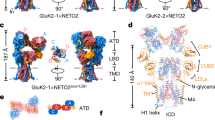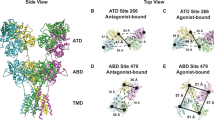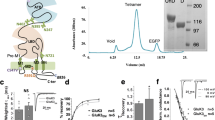Abstract
Glutamate receptors are ligand-gated tetrameric ion channels that mediate synaptic transmission in the central nervous system. They are instrumental in vertebrate cognition and their dysfunction underlies diverse diseases1,2. In both the resting and desensitized states of AMPA and kainate receptor subtypes, the ion channels are closed, whereas the ligand-binding domains, which are physically coupled to the channels, adopt markedly different conformations3,4,5,6. Without an atomic model for the desensitized state, it is not possible to address a central problem in receptor gating: how the resting and desensitized receptor states both display closed ion channels, although they have major differences in the quaternary structure of the ligand-binding domain. Here, by determining the structure of the kainate receptor GluK2 subtype in its desensitized state by cryo-electron microscopy (cryo-EM) at 3.8 Å resolution, we show that desensitization is characterized by the establishment of a ring-like structure in the ligand-binding domain layer of the receptor. Formation of this ‘desensitization ring’ is mediated by staggered helix contacts between adjacent subunits, which leads to a pseudo-four-fold symmetric arrangement of the ligand-binding domains, illustrating subtle changes in symmetry that are important for the gating mechanism. Disruption of the desensitization ring is probably the key switch that enables restoration of the receptor to its resting state, thereby completing the gating cycle.
This is a preview of subscription content, access via your institution
Access options
Subscribe to this journal
Receive 51 print issues and online access
$199.00 per year
only $3.90 per issue
Buy this article
- Purchase on Springer Link
- Instant access to full article PDF
Prices may be subject to local taxes which are calculated during checkout




Similar content being viewed by others
Accession codes
Data deposits
Cryo-EM density maps for GluK2EM with 2s,4R-4-methylglutamate, and GluK2EM with LY466195, have been deposited in the Electron Microscopy Data Bank under accession codes EMD- 8289 and EMD- 8290, respectively. Atomic coordinates for GluK2EM with 2s,4R-4-methylglutamate, GluK2EM with LY466195, GluK2EM LBD with 2s,4R-4-methylglutamate, and GluK2EM LBD with LY466195, have been deposited in the Protein Data Bank under accession codes, 5KUF, 5KUH, 5CMM and 5CMK, respectively.
Change history
21 September 2016
Missing labels were added to Fig. 4a, and minor orientation changes were made to Fig. 4e.
References
Burnashev, N. & Szepetowski, P. NMDA receptor subunit mutations in neurodevelopmental disorders. Curr. Opin. Pharmacol. 20, 73–82 (2015)
Lesca, G. et al. GRIN2A mutations in acquired epileptic aphasia and related childhood focal epilepsies and encephalopathies with speech and language dysfunction. Nat. Genet. 45, 1061–1066 (2013)
Dürr, K. L. et al. Structure and dynamics of AMPA receptor GluA2 in resting, pre-open, and desensitized states. Cell 158, 778–792 (2014)
Meyerson, J. R. et al. Structural mechanism of glutamate receptor activation and desensitization. Nature 514, 328–334 (2014)
Schauder, D. M. et al. Glutamate receptor desensitization is mediated by changes in quaternary structure of the ligand binding domain. Proc. Natl Acad. Sci. USA 110, 5921–5926 (2013)
Sobolevsky, A. I., Rosconi, M. P. & Gouaux, E. X-ray structure, symmetry and mechanism of an AMPA-subtype glutamate receptor. Nature 462, 745–756 (2009)
Traynelis, S. F. et al. Glutamate receptor ion channels: structure, regulation, and function. Pharmacol. Rev. 62, 405–496 (2010)
Mayer, M. L. Glutamate receptors at atomic resolution. Nature 440, 456–462 (2006)
Watkins, J. C. & Evans, R. H. Excitatory amino acid transmitters. Annu. Rev. Pharmacol. Toxicol. 21, 165–204 (1981)
Chen, L., Dürr, K. L. & Gouaux, E. X-ray structures of AMPA receptor-cone snail toxin complexes illuminate activation mechanism. Science 345, 1021–1026 (2014)
Herguedas, B. et al. Structure and organization of heteromeric AMPA-type glutamate receptors. Science 352, aad3873 (2016)
Nakagawa, T., Cheng, Y., Ramm, E., Sheng, M. & Walz, T. Structure and different conformational states of native AMPA receptor complexes. Nature 433, 545–549 (2005)
Twomey, E. C., Yelshanskaya, M. V., Grassucci, R. A., Frank, J. & Sobolevsky, A. I. Elucidation of AMPA receptor-stargazin complexes by cryo-electron microscopy. Science 353, 83–86 (2016)
Yelshanskaya, M. V., Li, M. & Sobolevsky, A. I. Structure of an agonist-bound ionotropic glutamate receptor. Science 345, 1070–1074 (2014)
Zhao, Y., Chen, S., Yoshioka, C., Baconguis, I. & Gouaux, E. Architecture of fully occupied GluA2 AMPA receptor–TARP complex elucidated by cryo-EM. Nature 536, 108–111 (2016)
Alushin, G. M., Jane, D. & Mayer, M. L. Binding site and ligand flexibility revealed by high resolution crystal structures of GluK1 competitive antagonists. Neuropharmacology 60, 126–134 (2011)
Jones, K. A., Wilding, T. J., Huettner, J. E. & Costa, A. M. Desensitization of kainate receptors by kainate, glutamate and diastereomers of 4-methylglutamate. Neuropharmacology 36, 853–863 (1997)
Möykkynen, T., Coleman, S. K., Semenov, A. & Keinänen, K. The N-terminal domain modulates α-amino-3-hydroxy-5-methyl-4-isoxazolepropionic acid (AMPA) receptor desensitization. J. Biol. Chem. 289, 13197–13205 (2014)
Dutta, A. et al. Cooperative dynamics of intact AMPA and NMDA glutamate receptors: similarities and subfamily-specific differences. Structure 23, 1692–1704 (2015)
Carbone, A. L. & Plested, A. J. Coupled control of desensitization and gating by the ligand binding domain of glutamate receptors. Neuron 74, 845–857 (2012)
Fleck, M. W., Cornell, E. & Mah, S. J. Amino-acid residues involved in glutamate receptor 6 kainate receptor gating and desensitization. J. Neurosci. 23, 1219–1227 (2003)
Chaudhry, C., Plested, A. J., Schuck, P. & Mayer, M. L. Energetics of glutamate receptor ligand binding domain dimer assembly are modulated by allosteric ions. Proc. Natl Acad. Sci. USA 106, 12329–12334 (2009)
Dawe, G. B. et al. Distinct structural pathways coordinate the activation of AMPA peceptor-auxiliary subunit complexes. Neuron 89, 1264–1276 (2016)
Plested, A. J., Vijayan, R., Biggin, P. C. & Mayer, M. L. Molecular basis of kainate receptor modulation by sodium. Neuron 58, 720–735 (2008)
Patneau, D. K., Mayer, M. L., Jane, D. E. & Watkins, J. C. Activation and desensitization of AMPA/kainate receptors by novel derivatives of willardiine. J. Neurosci. 12, 595–606 (1992)
Mayer, M. L. Crystal structures of the GluR5 and GluR6 ligand binding cores: molecular mechanisms underlying kainate receptor selectivity. Neuron 45, 539–552 (2005)
Meyerson, J. R. et al. Self-assembled monolayers improve protein distribution on holey carbon cryo-EM supports. Sci. Rep. 4, 7084 (2014)
Li, X. et al. Electron counting and beam-induced motion correction enable near-atomic-resolution single-particle cryo-EM. Nat. Methods 10, 584–590 (2013)
Tang, G. et al. EMAN2: an extensible image processing suite for electron microscopy. J. Struct. Biol. 157, 38–46 (2007)
Scheres, S. H. RELION: implementation of a Bayesian approach to cryo-EM structure determination. J. Struct. Biol. 180, 519–530 (2012)
Mindell, J. A. & Grigorieff, N. Accurate determination of local defocus and specimen tilt in electron microscopy. J. Struct. Biol. 142, 334–347 (2003)
Scheres, S. H. Beam-induced motion correction for sub-megadalton cryo-EM particles. eLife 3, e03665 (2014)
Pettersen, E. F. et al. UCSF Chimera--a visualization system for exploratory research and analysis. J. Comput. Chem. 25, 1605–1612 (2004)
The PyMOL Molecular Graphics System. Version 1.8 Schrödinger, LLC. (DeLano Scientific, 2002)
Smart, O. S., Goodfellow, J. M. & Wallace, B. A. The pore dimensions of gramicidin A. Biophys. J. 65, 2455–2460 (1993)
Heymann, J. B. Bsoft: image and molecular processing in electron microscopy. J. Struct. Biol. 133, 156–169 (2001)
Adams, P. D. et al. PHENIX: a comprehensive Python-based system for macromolecular structure solution. Acta Crystallogr. D Biol. Crystallogr. 66, 213–221 (2010)
Emsley, P., Lohkamp, B., Scott, W. G. & Cowtan, K. Features and development of Coot. Acta Crystallogr. D Biol. Crystallogr. 66, 486–501 (2010)
Wang, R. Y. et al. De novo protein structure determination from near-atomic-resolution cryo-EM maps. Nat. Methods 12, 335–338 (2015)
Horning, M. S. & Mayer, M. L. Regulation of AMPA receptor gating by ligand binding core dimers. Neuron 41, 379–388 (2004)
Acknowledgements
This research was supported by the intramural programs of the NCI, and NICHD, NIH, the IATAP program at NIH, and the NIH-FEI Living Laboratory for Structural Biology. Synchrotron diffraction data was collected at Southeast Regional Collaborative Access Team (SER-CAT) 22-ID beamline at the Advanced Photon Source (APS), Argonne National Laboratory. Use of APS was supported by the US Department of Energy, Office of Science, Office of Basic Energy Sciences, under contract number W-31-109-Eng-38. We thank D. Bleakman for the gift of LY466195, C. Glasser for preparing DNA constructs, and F. DiMaio and colleagues for assistance with use of the program Rosetta. We also thank V. Falconieri for preparing the schematic illustration panel. This study used the capabilities of the HPC Biowulf cluster at NIH, Bethesda, MD (http://hpc.nih.gov).
Author information
Authors and Affiliations
Contributions
J.R.M., M.L.M. and S.S. were involved in all stages of design of experiments and interpretation of results; S.C. carried out protein expression and purification; S.C. and M.L.M. carried out X-ray crystallography; T.H., E.S. and M.L.M. performed electrophysiological experiments; J.R.M., A.M., P.R. and S.C. carried out cryo-EM data collection; J.R.M. carried out cryo-EM image processing; J.R.M. and M.L.M. carried out structural analysis; J.R.M., M.L.M. and S.S. integrated all of the data, analysis of the implications and mechanism, and wrote the manuscript, with help from S.C.
Corresponding authors
Ethics declarations
Competing interests
The authors declare no competing financial interests.
Additional information
Reviewer Information Nature thanks L. Wollmuth and the other anonymous reviewer(s) for their contribution to the peer review of this work.
Extended data figures and tables
Extended Data Figure 1 Desensitized GluK2 imaging and structure determination.
a, b, Representative cryo-EM image of GluK2EM solubilized in DDM–CHS and bound by 2S,4R-4-methylglutamate (a), with the corresponding image power spectrum and CTF estimate showing signal beyond 3 Å resolution (b; solid and dotted lines, respectively). The defocus value for the image is 1.5 μm. Particles in a are highlighted with circles, and image binning at 4× and uniform level adjustments were used to make particles apparent. Scale bar, 500 Å. c, Subset of selected two-dimensional class averages. d, FSC curve with reported resolution of 3.8 Å at the 0.143 crossing. e, Structure of agonist-bound GluK2EM, coloured according to local resolution, shown at three progressively increasing contours.
Extended Data Figure 2 Desensitized GluK2 transmembrane and glycosylation features.
a, b, Cryo-EM density for resolved S1–M1 (a) and M3–S2 (b) linkers and transmembrane helices, displayed with Cα trace of the atomic model. c, Representative sites with densities for complex glycans at Asn244, Asn347 and Asn399.
Extended Data Figure 3 Reconstruction of desensitized GluK2 without computational symmetry.
a, Cryo-EM density map for the reconstruction of agonist-bound GluK2 without imposition of computational symmetry, and coloured according to local resolution. b, FSC curve with reported resolution of 4.4 Å at the 0.143 crossing. c, Segmentation of individual GluK2 chains of the asymmetric reconstruction. The density map segmentation is shown fitted with a trace representation of the model displayed in Fig. 1b.
Extended Data Figure 4 Inhibition of GluK2EM by LY466195 and LBD crystal structures for agonist and antagonist complexes.
a, Crystal structure for the GluK2EM-isolated LBD dimer assembly complex with 2S,4R-4-methylglutamate. The upper and lower lobes for the two subunits are coloured orange and pale yellow, and teal and pale cyan, respectively; the dashed line indicates the separation of the lower lobes measured as the distance between the Cα positions of Ile637. b, Crystal structure for the GluK2EM-isolated LBD dimer assembly complex with LY466195 illustrating the large decrease in separation of the lower lobes compared to the agonist complex. Colouring is the same as in a. c, Responses to 100 μM glutamate recorded under two electrode voltage clamp for GluK2EM (top) and wild-type GluK2 (bottom); the initial response to glutamate recorded after prior application of 300 nM LY466195 showed nearly complete block for GluK2EM, with no change in amplitude for wild type. d, Concentration dependence for inhibition of GluK2EM by LY466195 yielded an IC50 of 30 nM; data points show mean ± s.e.m. of 4–7 observations per concentration.
Extended Data Figure 5 Imaging and structure of GluK2EM bound by antagonist LY466195.
a, b, Representative cryo-EM image of GluK2EM solubilized in DDM-CHS and bound by LY466195 (a), with the corresponding image power spectrum and CTF estimate showing signal beyond 6 Å resolution (b, solid and dotted lines, respectively). The defocus value for the image is 2.7 μm. Particles in a are highlighted with circles, and image binning at 4× and uniform level adjustments were used to make particles apparent. Scale bar, 500 Å. c, Subset of selected two-dimensional class averages. d, Cryo-EM density map for GluA2 bound to ZK200775 (ref. 4) (left), density map for GluK2EM bound to LY466195 (middle) and its corresponding molecular model built from ATD and LBD dimers (right). e, FSC curve with reported resolution of 11.6 Å at 0.143 crossing.
Extended Data Figure 6 ATD–LBD interface of desensitized GluK2.
a, Desensitized GluK2 shown in surface representation with ATD–LBD interfaces highlighted. b, Top-down view of LBD layer shown with perspective indicated by eye icon in a. c, Underside of the ATD layer as viewed after peeling away from LBD layer. Dashed lines in a highlight where the layers are separated. In all panels, interfaces on chain A and C are in green and blue, respectively. d, Table with residues that mediate ATD–LBD interaction. e, f, Cartoon representation of LBD and ATD layers from same views as in b and c, with interface residues coloured to correspond with table in d.
Extended Data Figure 7 Desensitization ring residues that influence recovery kinetics.
a–d, Rate of recovery from desensitization measured using twin pulse applications of 10 mM glutamate (data points show mean ± s.d.; fits are shown in red). a, Wild-type GluK2 fit with a single exponential. b, D672R fit with the sum of two exponentials with the response for wild type shown as a black line; c, S669R D672R double mutant fit with the sum of two exponentials with the response for wild type shown as a black line. d, Time to 50% recovery in seconds. e–h, Top views of the GluK2 desensitization ring with residues found to influence recovery kinetics when mutated. Each panel shows the wild-type residue Cα position as a sphere. Positions for the S669R and D672R mutations from the present study are shown in e and f, respectively. The A676T and S679R positions found in previous studies20,21 are in g and h, respectively.
Supplementary information
Model for the kainate receptor state transitions
The transitions between resting, activated, and desensitized states are shown here. The resting and desensitized state models were built as described in the methods section. The activated state model was built using the GluA2EM activated state and GluA2cryst structures as guides to reveal conformational changes in the ATD and LBD layers, with the GluA2cryst ion channel used as a reference for positioning in the vertical plane. (MOV 13322 kb)
Rights and permissions
About this article
Cite this article
Meyerson, J., Chittori, S., Merk, A. et al. Structural basis of kainate subtype glutamate receptor desensitization. Nature 537, 567–571 (2016). https://doi.org/10.1038/nature19352
Received:
Accepted:
Published:
Issue Date:
DOI: https://doi.org/10.1038/nature19352
This article is cited by
-
Photoswitching fingerprint analysis bypasses the 10-nm resolution barrier
Nature Methods (2022)
-
GluN2A and GluN2B NMDA receptors use distinct allosteric routes
Nature Communications (2021)
-
Structural basis of ketamine action on human NMDA receptors
Nature (2021)
-
Allosteric coupling of sub-millisecond clamshell motions in ionotropic glutamate receptor ligand-binding domains
Communications Biology (2021)
-
The structural arrangement at intersubunit interfaces in homomeric kainate receptors
Scientific Reports (2019)
Comments
By submitting a comment you agree to abide by our Terms and Community Guidelines. If you find something abusive or that does not comply with our terms or guidelines please flag it as inappropriate.



